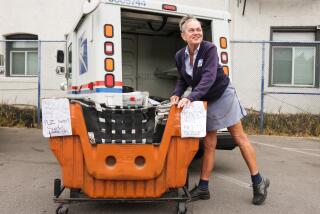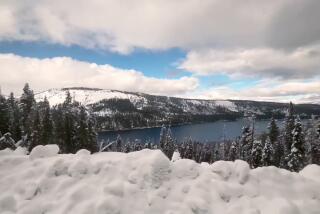If Mules Come Through, the Mail Goes Through at the Grand Canyon
- Share via
SUPAI, Ariz. — Charlie Chamberlain, clad in a black cowboy hat and fringe-trimmed chaps, slides a rope around boxes and white U.S. mail crates, knotting them snugly to the backs of his mules.
His horse then clippity-clops down the trail with the mules in tow. The red rock walls of the Grand Canyon rise around him. Dust wafts in his wake.
In an age of instant global communication, Chamberlain, a U.S. Postal Service contractor, might seem out of date. He delivers mail to the Havasupai Indian Reservation the same way it’s been delivered for a century.
For the 600 people who live on the reservation, which covers a branch of the Grand Canyon, and the thousands more who visit each year, Chamberlain and other wranglers provide a lifeline to the outside world.
They supply mail service--and, with it, everything imaginable--to this village only accessible by foot, horseback or helicopter.
Everything from fresh fruit to candy bars and from meat to french fries is mailed here, all at the standard Postal Service rate. Usually a crate of letters and magazines gets into the daily load too.
“It’s amazing what people can do when they put their minds to it. They can pack things you never would have thought,” said Chamberlain, who counts a disassembled washing machine among his most unusual deliveries.
The U.S. Postal Service established the mail route in 1896, using a relay of trains, wagons and mules to deliver the mail.
Now the food and other household items are delivered to the tan brick post office in Peach Springs, about 70 miles from the Havasupai Reservation trail head.
There they are greeted by postmaster LeRoy Hurst and two other workers who simply scribble “cafe,” “store” or “lodge” to address the boxes of toilet paper, tubs of laundry detergent and crates of strawberries destined for the bottom of the canyon.
Some of the items, such as milk and meat, are put in the post office’s walk-in freezer to make sure they are frozen solid for the trek down.
“The chopper takes the ice cream. That’s about the only thing we can’t take,” said Hank DeLaney, the contractor who takes the mail from the post office to the trail head.
Five days a week, DeLaney pulls his delivery truck in front of a sign that reads “U.S. Mail Delivery Zone. Leave clear at all times.” There he meets the wranglers whose mules are tied at the hitching post awaiting their next load.
The mules, led by at least one wrangler, climb and trot their way 8 miles from the trail head to Supai, where they make their delivery.
The mule train mail is one of a number of unusual routes used by the Postal Service to deliver mail to some of the nation’s remotest spots. Under the agency’s charter, it must provide uniform service at a uniform price, said Postal Service spokesman Mark Saunders.
That’s why the U.S. Postal Service uses more than its fleet of white trucks to deliver mail; it uses boats to deliver to islands, snowmobiles to deliver to parts of Alaska and skis to deliver to part of Idaho.
“We’re the last entity that makes house calls to every address in America,” Saunders said. “We deliver all sorts of crazy things. You wouldn’t believe what we mail.”
Chamberlain would. Everything from Christmas trees to eggs has gone down on his mules.
Most everything gets there in one piece, Chamberlain said, but occasionally a load gets thrown from a mule. And once in a long while, Chamberlain loses a mule altogether.
Earlier this year, one of his mules was bumped off the narrow, steep zigzags of the trail and killed. That meant Chamberlain had to collect firewood to cremate the mule on the spot.
It’s “just part of the way of life here. It’s not something you sign up for on the Internet,” Chamberlain said. “You have to really love it.”
More to Read
Sign up for Essential California
The most important California stories and recommendations in your inbox every morning.
You may occasionally receive promotional content from the Los Angeles Times.










